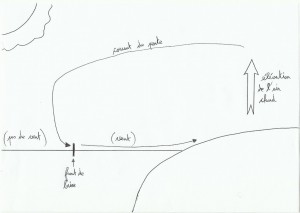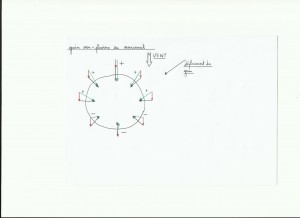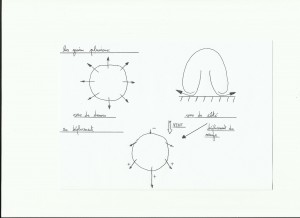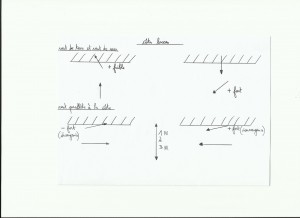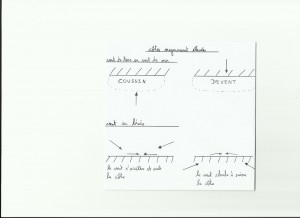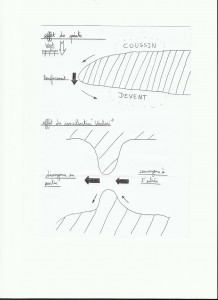1)Sea breeze
It's coming from a temperature's difference between the air above the sea and the air above the land. This difference causes a movement of air flow as a small convective cell; the lighter warm air on land will rise , creating a lack of air filled by an air flow coming from the sea.
Water is slower to warm itself than land's surface as day goes along. The sea breeze begins mainly early in the afternoon when the land has had enough time to warm itself. Breeze always chooses the shortest path to reach, At the beginning often perpendicular to the coast, it turns to the right during the day in easing off(about 5/10 ° per hour)and it's finally parallel and mostly stops early in the evening. Sea breeze is characterized by the presence of cumulus(clouds in pieces of cotton shapes at low altitude) above the coast and not above the water, when those clouds have grown it's a sign that sea breeze will soon stop.
This phenomenon requires a factor's combination to exist: requires a difference significant temperature between land and sea, a synoptic wind below 15 knots, a long sunshine, a clear horizon offshore, a short Coast and a synoptic wind orientation must come roughly from the coast to avoid a break down on the air flow("courant de pente on the graph")("règle des quadrans in French").
2)Squalls
These clouds alter the strength and direction of the synoptic wind on their way, there are two kinds of squalls:
.Squalls without pouring rain
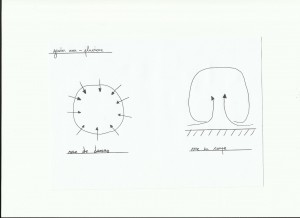 They work like a vacuum cleaner which inhales surface's air aloft, creating a local wind. Sometimes when we cross a stormy squall offshore, we have a strange view that the squall moves on the opposite direction depending on surface's wind. In fact surface's wind felt is the air pumped up by the squall.
They work like a vacuum cleaner which inhales surface's air aloft, creating a local wind. Sometimes when we cross a stormy squall offshore, we have a strange view that the squall moves on the opposite direction depending on surface's wind. In fact surface's wind felt is the air pumped up by the squall.
Motions
Squall wind added with synoptic wind provides the wind felt in green. The wind is stronger at the top of the grain and lower down on the little draw. In the northern hemisphere squalls move from right to left when we are in face with the synoptic wind(because of less frictions with surface in altitude).
.The wet squalls
Unlike squalls without rain, this time we will find more wind down to the squall and less on its top(cf draw).
3)Coast effects
Coastal landforms as we saw at the beginning sometimes changes the synoptic wind with temperature, but its shape also affects.
.For low coast(example south of Brittany)
With frictional's forces stronger here the wind turn on the left when it's closer to the coast.
.moderately high coasts
When the wind is perpendicular to the coast and just offshore it creates a windless zone called “cushion” near the coast. If it comes from land it also creates a windless zone, the “dévent in french”; the more high the coast will be the more wide this windless zone will be.
For high coasts such as Corsica, differences in altitude change the nature of air masses.
4)Peak effect and Venturi effect
Peak effect is felt around the capes, Venturi effect occurs at the mouths(example Morbihan gulf, Gibraltar strait). Those things due to the coastal shape increase synoptic wind strengh.
